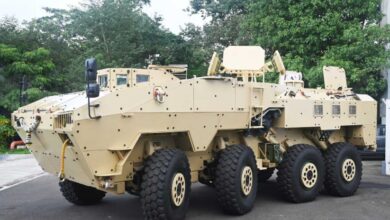The Indian Ocean’s Crucial Role In China’s Prospective Taiwan Conflict

- According to analytics firms Vortexa and Kpler, it has enough crude oil for about 60 days of strategic and commercial use.
- The report should also look at how much China might be able to meet its energy needs during a crisis or conflict by keeping supplies on hand
Nearly 60 very large crude oil carriers sail every day between ports in the Persian Gulf and China, carrying about half of the oil that powers the world’s second-largest economy.
As the ships go into the South China Sea, the area is controlled by China’s growing military more and more, from the Type 055 destroyers and missile batteries at its bases on disputed islands to the ships.
But when they cross the Indian Ocean with other tankers going to China from Africa and Brazil, they are not protected in a naval area controlled by the United States.
About a dozen military attachés and scholars say that vulnerability is being looked at right now as Western military and academic strategists secretly play out different ways that a conflict with China over Taiwan or somewhere else in East Asia could develop or get worse.
David Brewster, a security expert at the Australian National University, said that Chinese oil tankers in the Indian Ocean “would find themselves very vulnerable” in a major war.
“If there were a war, Chinese naval ships would be stuck in the Indian Ocean with little or no air support because China doesn’t have any bases or facilities of its own.”
Four envoys and eight analysts who have been to Western and Asian capitals and heard what was said said that China’s long-term weakness gives its enemies a range of ways to escalate the conflict, especially when it lasts for a long time, like Russia’s war in Ukraine.
These possible outcomes include everything from operations to harass and stop Chinese ships, which could lead Chinese naval ships to the area, to a blockade and even worse.
Three analysts say that in a full-scale war, the tankers, which can hold two million barrels of oil, would be targets to be sunk or captured. This is similar to naval actions from the last century, where enemies went after their enemies’ economic resources.
One way to stop China from acting is to give them these options. Another way is to make an invasion of Taiwan more expensive.
The people said it wasn’t clear how this weakness changes Beijing’s thinking about Taiwan.
When asked about its position in the Indian Ocean, China’s defense ministry did not answer.
People’s Liberation Army (PLA) documents and retired officers say that Chinese strategists are aware of the problem, but President Xi Jinping would be the one to decide if military action should be taken.
In February, William Burns, director of the U.S. Central Intelligence Agency, said that Xi had told the PLA to be ready to invade Taiwan by 2027. China has been moving its military around more in preparation for the island’s January elections.
Since they took power in 2013, Xi and other Communist Party leaders have stressed how important it is to have a modernized military that can project power around the world and protect China’s important trade routes.
But because they were afraid of a fight, some analysts said China would find it hard to protect these lifelines as its energy needs rise. This would make it hard to keep up a long war over Taiwan.
China bought 515.65 million tons of crude oil from other countries in the 11 months ending in November. That’s 11.27 million barrels per day, which is a 12.1% increase year-over-year.
The Pentagon says that the Malacca Strait and the South China Sea, which are important entrances to the Indian Ocean, carry about 62% of China’s oil imports and 17% of its natural gas imports.
China is trying to get oil from more than one place. According to customs data and state media, three pipelines from Russia, Myanmar, and Kazakhstan will bring in about 10% of China’s crude oil in 2022.
After Russia invaded Ukraine, the West put sanctions on Moscow. This has caused China to stock up on more cheap oil from Russia, which is its main supplier.
More goes into food than meets the eye. Some of China’s imports, like soybeans that are used to feed animals, go through the Indian Ocean. Other goods, like potash that is used to make fertilizer, come in through different routes.
BASE SURROUNDED
China has a large network of military satellites, but only one military base. There is also no air cover from land or sea for naval deployments in the Indian Ocean.
In its October annual report on China’s military, the Pentagon lists 11 possible Chinese bases near the ocean. Pakistan, Tanzania, and Sri Lanka are on the list. As part of Xi’s Belt and Road Initiative, China is reaching out to these places in a diplomatic and business sense.
But, according to the attaches and an Asian diplomat, these have not turned into hard military assets. There is neither a permanent PLA presence nor public guarantees of ability to get there in a conflict.
The Pentagon report says that China still “has little power projection capability” in the Indian Ocean. This is the first time that phrase has been used this year.
China’s first overseas base opened in 2017 in Djibouti, which is on the western edge of the ocean. It is home to 400 marines and shows that China has been involved in international patrols for piracy around the Horn of Africa since 2008.
There are military bases from seven other countries, including the US, France, and Britain, on either side of the base. The base does not have an airfield, though.
The U.S. presence in the Indian Ocean is still very different, showing how it was built up during the Cold War.
The U.S. 5th Fleet is based in Bahrain, and the Japan 7th Fleet is based in Diego Garcia, an atoll administered by the U.K. that has runways for long-range bombers and a lagoon big enough to hold U.S. aircraft carriers.
To the east, Australia is increasing patrols with its submarine-hunting P-8 Poseidon planes and building up a base on the west coast for British and American nuclear-powered submarines and, eventually, Australian nuclear-powered boats.
WORK IN PROGRESS
Zhou Bo, a retired senior colonel in the PLA and a security fellow at Tsinghua University in Beijing, said he knew there were debates in other countries about how weak China was, but the scenarios were just made up.
Zhou said that if China and the West started a war in the Indian Ocean, it would be “almost uncontrollable” in terms of size and location. “At that point, it’s a big war with many countries involved,” he said.
Still, he said, China would slowly increase its deployments and base options to make itself stronger.
Military attachés and analysts who keep an eye on deployments in the Indian Ocean say that China always has four or five surveillance ships, the same number of warships, and an attack submarine. One former Western intelligence analyst said that China has not yet put its most powerful assets in the Indian Ocean to the test.
Some analysts think that will change, especially since PLA documents stress how important the patrols are for keeping supply lines safe in the Indian Ocean. The 2020 Science of Military Strategy, an official document outlining China’s strategic priorities, says that China could increase patrols if “hegemonic countries” control its important trade routes.
China’s navy keeps its ballistic missile submarines with nuclear weapons close to its base on Hainan Island. However, as its attack submarines get better, they will be able to go farther, which will be a challenge for the U.S.
“We can see they are being cautious, definitely more cautious than expected,” said retired U.S. Rear Admiral Michael McDevitt. In a book published in 2020, he said that China would eventually have a large military presence to protect the sea lanes in the Indian Ocean.
“I’m not saying they won’t get there, but it looks like they aren’t there yet, especially with their aircraft carriers. Getting more air cover will be very important for them in a conflict.”
BLOCKADE TROUBLES
Some analysts say that China might still be able to succeed even if it can’t become the most powerful country.
Because trade is so fluid and oil is sometimes traded along the way, blockades are hard to put in place.
It would be very hard to keep track of and police shipments because operations against China would need to make sure that shipments get to places like Japan, South Korea, and Australia safely.
Brewster said, “You just can’t get away with stopping your enemy’s shipments while letting your own go on.”
Historians are still arguing about how well blockades worked against Germany in World War I and Japan in World War II.
China has learned some things, though. According to analytics firms Vortexa and Kpler, it has enough crude oil for about 60 days of strategic and commercial use. Satellites can’t find its oil reserves because some of them are buried underground.
It doesn’t have a lot of extra natural gas, but it is getting more and more from pipelines that run through Russia, Central Asia, and Myanmar.
China grows most of its own wheat and rice and keeps large amounts of both on hand, though the exact amounts are kept secret.
In 2022, the U.S.-China Economic and Security Review Commission asked the Pentagon to make a secret report on the military needs of a blockade on China’s energy shipments. This report included information that had not been made public before.
The commission said, “The report should also look at how much China might be able to meet its energy needs during a crisis or conflict by keeping supplies on hand, rationing them, and relying on overland shipments.”







Facebook Comments